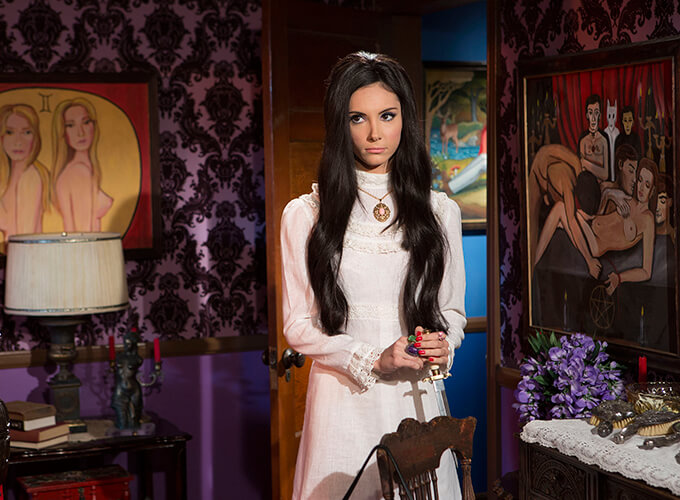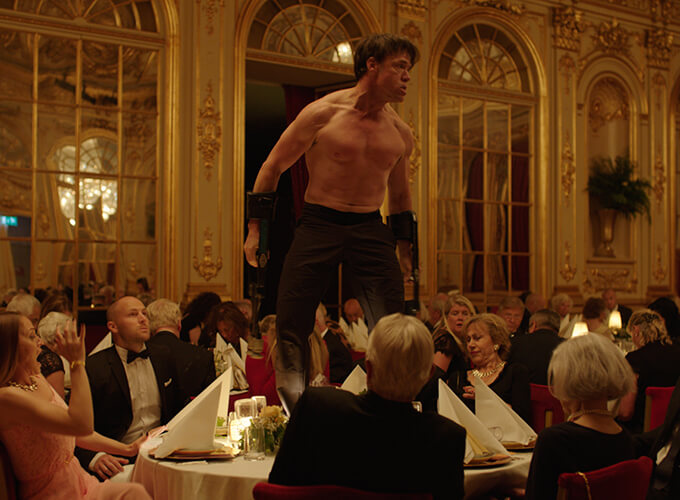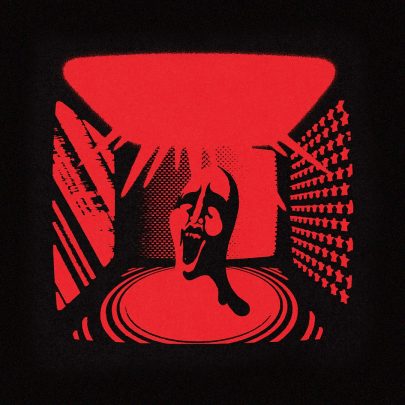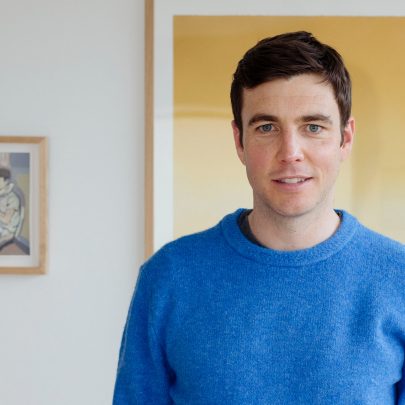Jul 25, 2017 Film & TV
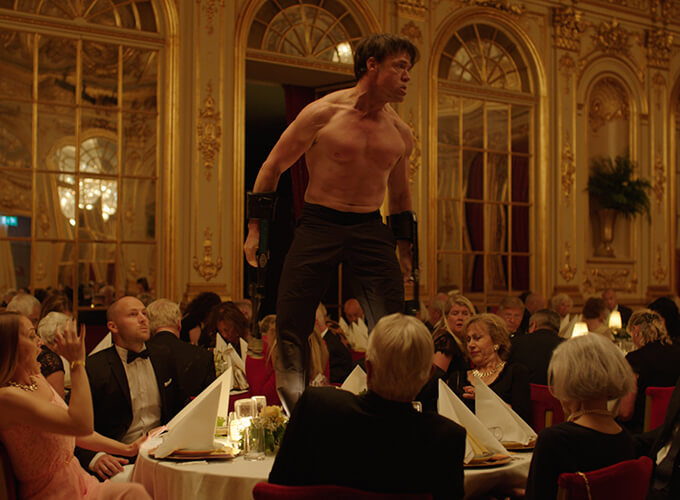
She was talking about The Square, which we had both seen at the festival’s opening night. As I write, that’s four nights ago; it’s also 13 films ago, but happily I took a lot of notes. Here are some of them: “Bill is unwell”. “The Tesla of Justice!” “The snow-grooming scene. The cleaning scene”. “THE STAIRWELL IS A DIAMOND AND A DIAMOND IS A SQUARE.” “I’m afraid I can’t help you”. The rest are illegible. (I don’t know whether you’ve ever tried writing by the light of The Civic’s starry ceiling, but I can’t recommend it.)
The Square is the second film from Swedish writer-director Ruben Östlund, whose debut feature, Force Majeure, was one of the knock-out surprises of NZIFF 2014. The memory of that surprise — that moment of realising that the punt I’d taken on the interesting-sounding newbie had scored me something clean and sharp and dangerous, which I would never be able to forget, whether I wanted to or not — gave The Square a high expectations bar to clear. Also, small detail re expectations, it won the Palme d’Or at Cannes in May. I’m trying to remember when we last had the Palme d’Or winner as the opening night film. I think that would be never. (Yes, yes, it probably happened at some point in the last five decades. Shut up, I’m trying for drama.)
So that in itself becomes another thing I won’t forget. Barely two months after its Cannes premiere, with most of the planet’s film geeks still waiting to see it, we got to open our film festival by sitting in the best theatre in the country and taking the measure of Östlund’s difficult second album. It did not match Force Majeure, for my money; too many moving parts, the shape they formed a little too messy, a couple of key elements not quite fit for purpose. But I don’t need my sheaf of illegible notes. So memorable. So interesting! So much to chew on and so many bravura sequences. Östlund delivers a savagely funny satire in the hard-out Swiftian mode, so close to our global society’s bone that it was sometimes hard to know whether to laugh or scream. There were arguments afterwards as to whether the ape man scene was too over the top. I am not going to describe the ape man scene; I am not going to say much about the specifics of this film at all, because, see above, there are people out there who haven’t seen it yet. But too over the top? This is like arguing about whether infinity isn’t perhaps a little on the large side. The ape man scene is exactly as OTT as it needs to be, and it’s also evidence that Östlund, should he happen to desire to make a point, is happy to opt for the point of a very blunt rapier, which he will then shove through your eye. He requires that you think, but he isn’t going to pat you on the back for it; he entertains you lavishly, but he doesn’t seem to care if you admire him. Bring me his third film, please.
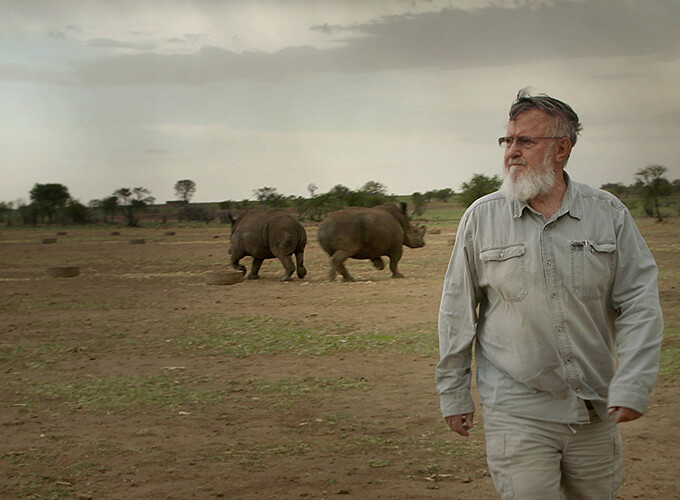
So then I got up on Friday and went to four more films, and then on Saturday I did it again, and then on Sunday I also did it again. Obviously I’m bragging. This is me in my happy place, and when the happy place happens to coincide with the Civic I get especially happy about it. This is also me in a this-is-your-brain-on-too-much-art public service ad. I have so far scored one grand lifetime high, two exceptional documentaries, two random duds, one heart-breakingly lovely animated memoir, one deserving Palme d’Or winner, four variously flawed instances of entertaining unlikeliness, one useful confirmation of my long-held suspicion that I should stop bothering with Sofia Coppola, and one thing from the Incredibly Strange section of the programme, which I may eventually work out how to describe. Holding all of this in my head is a little difficult, and the festival has another 13 days to run. I am beginning to obsess about meaningless recurring motifs, which does not usually happen before the end of the first week. There have been some very good elephants in some of these films, for instance. Though granted, one of them was shot in the head.
That happened in the first of my two exceptional documentaries, Trophy. An exploration of the ethical complexities of big game hunting? Sure, okay. I went to this because there was nothing else on in the time slot I much wanted to see; I am sceptical of documentaries as a form partly because of films which purport to examine ethical complexities. What tends to happen instead is that they edit the complexities down to a carefully manicured thesis-anthithesis, where the synthesis is what the director would like you to believe. But in this case the complexities are not that complex: animal species are becoming extinct, it’s because of us, and there are things we can do about it, most of which we’re not doing. Some of them may involve managed hunting. The arguments for and against are forcefully and involvingly presented, and, the film’s big trump card, we spend a lot of time with the animals: a book could do this subject in more depth, but it couldn’t put you down in front of a herd of trundling rhinos and let you marvel at how huge they are. This is a textbook issue documentary; I can’t imagine a better version of it.
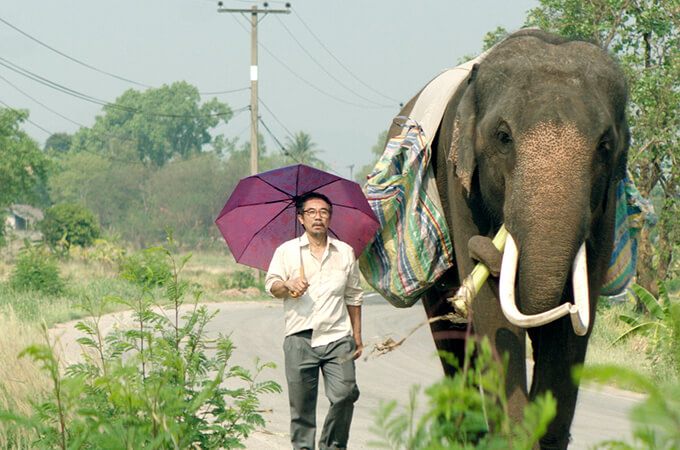
Second exceptional doc: I Am Not Your Negro. Oscar-nominated and here at last; I’ve been hearing rave American reviews since late last year. That would be because it’s an American film about America, specifically about James Baldwin’s writings on race, racism, and the deaths of Malcolm X, Medgar Evers, and Martin Luther King. Key words: sobering, chastening, potent, enraging. It’s densely woven and throws a lot at you fast; if you’re not up on the history of the civil rights movement, be prepared to do some googling afterwards. You’ll want to.
Oh, and speaking of racism in America — Sofia Coppola. Sofia Coppola, Sofia Coppola, Sofia Coppola. Look, nearly everyone loves Lost In Translation. I am the “nearly”, and I have no bone to pick with the rest of you on this one. But I have plenty of bones to pick with the rest of her directorial output, most especially her latest film, The Beguiled, an American civil war domestic drama in which slavery is quietly ignored. Equally notable by their absence: period language, regional accents, physics, characterisation, spatial relationships, and plausibility. The cast is remarkably strong — Nicole Kidman, Kirsten Dunst, Elle Fanning, and Colin Farrell as the wounded northern soldier who turns up at the Virginian girls’ school where they all live — and therefore there are some transient pleasures here to be had. Also the use of light is impressive; I passed some happy minutes watching dust motes. Coppola seemed interested in them too.
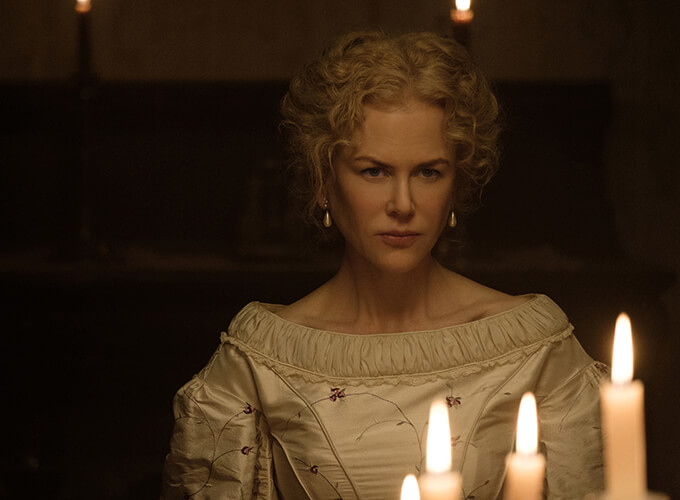
Elle Fanning is also in Twentieth Century Women, a funny, well made, slightly forgettable comedy-drama, with a fantastic Annette Benning performance at its core. It’s one of the four films I listed above as “variously flawed instances of entertaining unlikeliness”. The others: Pop Aye (Thai road movie, with elephant; slow, initially a little bitter, but wryly clever and eventually moving), Marjorie Prime (lightly science fictional dialogue-driven drama about old age and identity, featuring a toweringly good performance from Lois Smith), A Prayer Before Dawn (visceral, brutal prison drama, curiously mixed with generic underdog-sports-hero-triumphs storyline, yet powerful and immersive). Films like these are one major reason I try to go to as many things at the festival as I can. There is no world in which I would not eventually find a way to watch The Square. (Well there is, but it’s the one where I’m dead.) I have plenty of film geek friends who would spot something like Trophy and tell me about it. But without the festival I might easily never watch something like Marjorie Prime or Pop Aye, because on any fair description, these are low on the art film food chain. Lots of heart, lots of problems, no big fuss likely to be made. And yet. Lois Smith’s smile, when she plays an 85-year-old woman talking to the computer-generated avatar of her dead husband; her more serene, somehow less vital smile, when she plays a computer-generated avatar herself. I liked Marjorie Prime without loving it; but the gulf between those two smiles may be as good an acting achievement as I see this year.
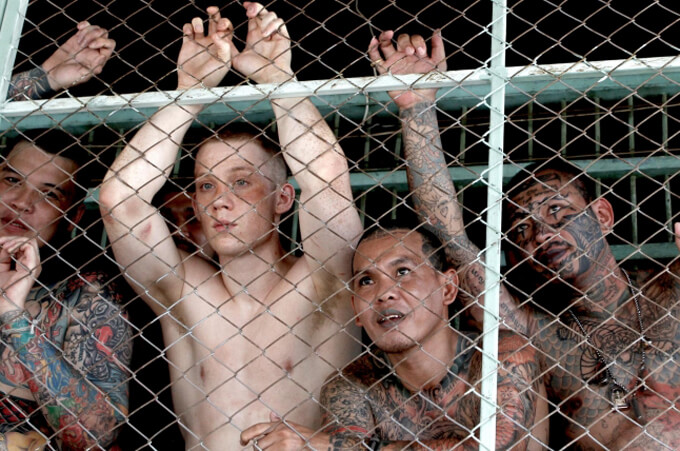
Please go to Ethel & Ernest. I expected to enjoy this. Animated film from a Raymond Briggs graphic novel? So very of-course-I’m-going-to that I didn’t pause to consider whether it might be extraordinarily floods-of-tears wonderful. I found it to be extraordinarily floods-of-tears wonderful. It’s possible that I’ve just ruined it for you, because it’s the most English film you can imagine, by which I mean the characters would be very embarrassed to have anyone cry over them. It’s quiet, modest, slow, understated, and only cumulatively devastating. It’s also the story of Raymond Briggs’s quiet, modest parents, from first meeting to death-do-us-part vows to parted-by-death. And it’s also the story of the English working classes in the middle third of the 20th century. Any number of films have attempted the “capture a tranche of social history through the story of one or two ordinary people observed over time” gambit. This is the best-case outcome for that strategy, partly because the voice acting is so good — imagine being Raymond Briggs and hearing Brenda Blethyn and Jim Broadbent play your parents — and partly because the animation is so unobtrusively effective. Mostly it’s the writing. Imagine being Brenda Blethyn and Jim Broadbent and getting to voice characters written by Raymond Briggs.
It isn’t really a children’s film, I should add, though it’s just about child-accessible. Quite a few kids were at the Rialto on Saturday. During one of the scenes in the wake of the Blitz, a minor character has to explain to someone why he’s sad. “I lost my boy”, he says. “Mum, what does that mean?” asked a five-year-old behind me. Very quietly and carefully, his mother told him. This was one of several moments where I found myself crying.
Did I mention a couple of duds? I would not trouble yourself with Hostages, which is a very beautifully shot period thriller but neither a thrilling nor an especially coherent one. Also it’s one of those maddening subtitled films where the subtitles only bother with half the dialogue; frequently several people will speak in quick succession, none of it seeming like throw-away lines, and only one character will be translated. And alas, the Australian comedy That’s Not Me sounded so edgy and smart. Nope.
“He said, one day you’ll understand”. I do not understand Andrei Tarkovsky’s Stalker, which until Saturday I had only ever seen on the small screen. I have been waiting years to see it at the Civic, and the last time I seriously looked into it the rights had become confused in the wake of the collapse of the Soviet Union, and no one seemed to expect it to become legally possible to screen it in the foreseeable future. Then it turned up in the festival programme. If ever my expectations have been ruinously high, it was for Stalker at the Civic. But since they did not extend to the idea that I would emerge with any great insight into what happens in the film, they were not high enough to defeat Tarkovsky in a spanking new digital print. Mark this down as one of my top 10 lifetime film festival experiences.
I know nothing about Aleksandr Knyazhinskiy, Tarkovsky’s cinematographer, except what Stalker makes obvious, which is that he is one of the great visual poets of water. No one can shoot water the way he does, and Tarkovsky asks him to do it again and again, in these long slow panning shots. (It’s a film full of long, slow panning shots and occasional violent cuts; and, as I may have mentioned, it’s hard to understand. Tarkovsky is supposed to have said once that he made the opening scene particularly boring, so that anyone who’d wandered into the wrong theatre would have time to escape. Just in case my enthusiasm moves you to run out and buy a ticket for one of the remaining screenings: fair warning.) The glory of light rippling in and off these fluid surfaces is what the Civic screen was made for, and also, at this scale you can see what’s in and under the water in so much more detail. Since the film is held together, to the extent that it holds together, by a quest plot that makes sense only in its final moments, and by recurring ideas and images, being able to see the images is particularly handy.
The film’s quest story follows the attempt of three nameless characters to reach the heart of the Zone, an area created by a mysterious event that may have been the work of aliens, or of something stranger. Why they’re going there, and what will happen if they make it, emerges only slowly, and this is a film that gives the word “slowly” a very severe reading. The characters are a scientist, a writer, and the stalker, a professional Zone venturer. They argue a lot. Their arguments are abstruse and trenchant, and give the film enough surface tension that its conceptual depths don’t drown you; but the main reason to sit through its 161 minutes is that it’s an entrancing film to look at. Towards the end, one character says, “I don’t understand anything at all. What’s the point of coming here?” You can invest a great deal of analysis and contemplation in Stalker, but the point of it is that it’s sublime.
And then there was The Love Witch.
That seemed like a good last sentence for this blog as I was writing it, but I suppose I owe you a little more. Seventies sexploitation meets feminist parable: deliberately appalling writing and sub-parodic plotting slays both of them stone dead. But! Gorgeous visual design comes to the rescue! Or is rescue actually needed? For people who can enjoy precision-crafted naff dialogue — a group which includes some of my smartest cinephile friends — this seems to have registered as a masterpiece. I myself am deaf to such delights. However, I saw The Love Witch at the revamped and revived Hollywood theatre in Avondale, with a riotously happy capacity crowd last thing on Friday night. That was pretty neat. There are many ways to be a bit of a film festival film.
